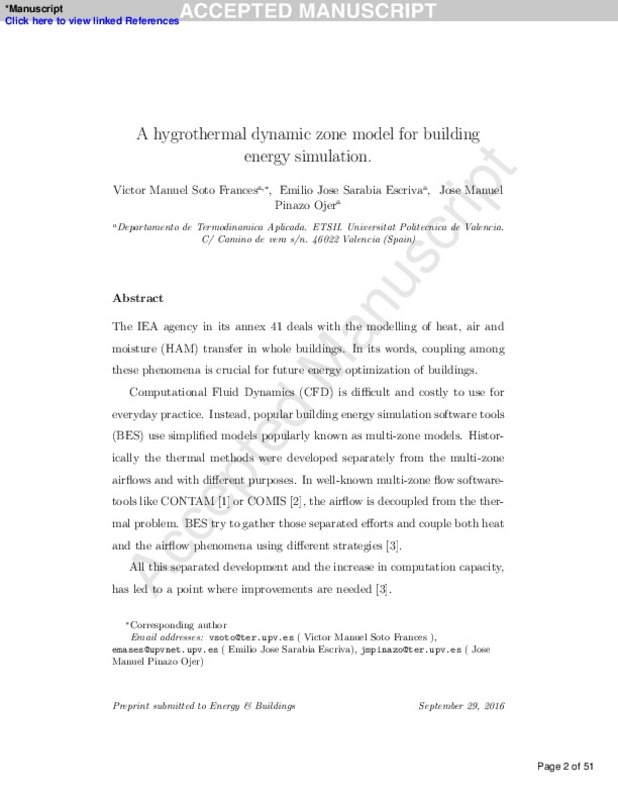JavaScript is disabled for your browser. Some features of this site may not work without it.
Buscar en RiuNet
Listar
Mi cuenta
Estadísticas
Ayuda RiuNet
Admin. UPV
A hygrothermal dynamic zone model for building energy simulation
Mostrar el registro sencillo del ítem
Ficheros en el ítem
| dc.contributor.author | Soto Francés, Víctor Manuel
|
es_ES |
| dc.contributor.author | Sarabia Escrivà, Emilio José
|
es_ES |
| dc.contributor.author | Pinazo Ojer, José Manuel
|
es_ES |
| dc.date.accessioned | 2017-04-04T11:20:55Z | |
| dc.date.available | 2017-04-04T11:20:55Z | |
| dc.date.issued | 2016-12-01 | |
| dc.identifier.issn | 0378-7788 | |
| dc.identifier.uri | http://hdl.handle.net/10251/79433 | |
| dc.description.abstract | The IEA agency in its annex 41 deals with the modelling of heat, air and moisture (HAM) transfer in whole buildings. In its words, coupling among these phenomena is crucial for future energy optimization of buildings. Computational fluid dynamics (CFD) is difficult and costly to use for everyday practice. Instead, popular building energy simulation software tools (BES) use simplified models popularly known as multi zone models. Historically the thermal methods were developed separately from the multi-zone airflows and with different purposes. In well-known multi-zone flow software-tools like CONTAM [1] or COMIS [2], the airflow is decoupled from the thermal problem. BES try to gather those separated efforts and couple both heat and the airflow phenomena using different strategies [3]. All this separated development and the increase in computation capacity, has led to a point where improvements are needed [3]. After a critical review of recent hygrothermal zone models, we present a proposal of a simplified zone model for the air-water mixture dynamics which can be used in BES. The resulting dynamical state variables are the zone dry temperature, absolute humidity, total pressure and dry air mass content. This means that, in contrast with other literature models, we employ three intensive and one extensive variable respectively. Moreover, the reference height level inside the zone cannot be chosen arbitrarily. The dynamic is obtained by using zone energy balance, balances of dry air and water mass content and the Equation of State for the wet air mixture. The zone can store dry air and water, therefore their density can change with time inside the volume. Inside the zone a hydrostatic pressure field is assumed with no kinetic energy storage. The resulting model is a made up of three non-linear ordinary differential equations and one algebraic equation. The model is automatically capable of dealing with wet air saturation conditions by using a special control signal alpha(control). | es_ES |
| dc.language | Inglés | es_ES |
| dc.publisher | Elsevier | es_ES |
| dc.relation.ispartof | Energy and Buildings | es_ES |
| dc.rights | Reserva de todos los derechos | es_ES |
| dc.subject | HAM | es_ES |
| dc.subject | Heat airflow moisture zone model | es_ES |
| dc.subject | Building energy simulation | es_ES |
| dc.subject | Multi-zone flow | es_ES |
| dc.subject | Saturation conditions | es_ES |
| dc.subject.classification | MAQUINAS Y MOTORES TERMICOS | es_ES |
| dc.subject.classification | TERMODINAMICA APLICADA (UPV) | es_ES |
| dc.title | A hygrothermal dynamic zone model for building energy simulation | es_ES |
| dc.type | Artículo | es_ES |
| dc.identifier.doi | 10.1016/j.enbuild.2016.10.002 | |
| dc.rights.accessRights | Abierto | es_ES |
| dc.contributor.affiliation | Universitat Politècnica de València. Escuela Técnica Superior de Ingenieros Industriales - Escola Tècnica Superior d'Enginyers Industrials | es_ES |
| dc.description.bibliographicCitation | Soto Francés, VM.; Sarabia Escrivà, EJ.; Pinazo Ojer, JM. (2016). A hygrothermal dynamic zone model for building energy simulation. Energy and Buildings. 133:389-402. doi:10.1016/j.enbuild.2016.10.002 | es_ES |
| dc.description.accrualMethod | S | es_ES |
| dc.relation.publisherversion | http://dx.doi.org/10.1016/j.enbuild.2016.10.002 | es_ES |
| dc.description.upvformatpinicio | 389 | es_ES |
| dc.description.upvformatpfin | 402 | es_ES |
| dc.type.version | info:eu-repo/semantics/publishedVersion | es_ES |
| dc.description.volume | 133 | es_ES |
| dc.relation.senia | 318569 | es_ES |
| dc.identifier.eissn | 1872-6178 |






![[Cerrado]](/themes/UPV/images/candado.png)


